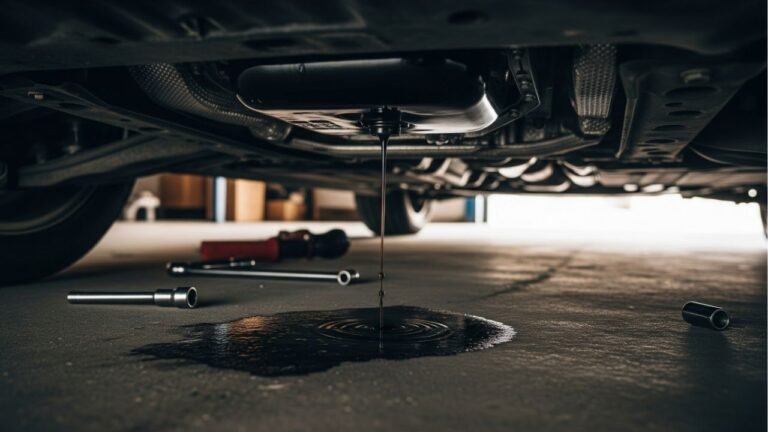Guide to Removing Oil from Car Seat

We’ve all been there. You’re cruising down the road, maybe eating some fries, maybe just got back from the mechanic—or worse, the gym—and suddenly you spot it. A nasty, greasy oil stain on your car seat. It could be engine oil from a workshop visit, cooking oil from fast food, or even baby oil. But regardless of how it got there, removing oil from car seat fabric is no small task.
It’s sticky, it spreads fast, and if you don’t treat it properly, it sets in like an unwanted tattoo. But don’t worry—I’ve been through this exact situation more times than I care to admit. From trial and error (and panic googling in parking lots), I’ve figured out how to deal with oil stains in a way that’s safe, affordable, and works like a charm.
In this detailed guide, I’ll walk you through every step of removing oil from car seat, so you won’t have to live with that greasy patch staring back at you ever again.
In This Article
- 1 Why Oil Stains Are So Hard to Remove
- 2 First Things First: Assess the Damage
- 3 Quick Action: What to Do Right After a Spill
- 4 Top DIY Methods for Removing Oil from Car Seat
- 5 Dealing with Leather Seats: A Softer Approach
- 6 Using Commercial Degreasers: When DIY Isn’t Enough
- 7 Drying the Seat Properly: Avoid Mold and Smell
- 8 Preventing Future Oil Stains
- 9 When to Call a Professional Cleaner
- 10 How Long Does It Take to Remove Oil from Car Seat?
- 11 Natural Alternatives vs. Chemical Cleaners: What’s Better?
- 12 Common Mistakes to Avoid When Removing Oil from Car Seat
- 13 Simple Maintenance Tips to Keep Your Car Seats Spotless
- 14 FAQs About Removing Oil from Car Seat
- 14.1 1. What is the best home remedy for removing oil from car seat?
- 14.2 2. Can I use laundry detergent instead of dish soap?
- 14.3 3. How do I remove oil from leather seats without damaging them?
- 14.4 4. Will the oil smell go away after cleaning?
- 14.5 5. Can I use a carpet cleaner on my car seats?
- 14.6 6. Is it safe to use a steam cleaner on oil stains?
- 14.7 7. How do I know if the stain is completely gone?
- 14.8 8. Does removing oil from car seat damage the fabric?
- 15 Final Thoughts: Keep Your Car Seats Fresh and Oil-Free
Why Oil Stains Are So Hard to Remove

And here’s the kicker—if you try scrubbing it with water and soap right away, you could accidentally push it in deeper. It’s like trying to clean peanut butter with more peanut butter. The texture fights back.
To successfully tackle removing oil from car seat, you need a method that lifts, absorbs, and breaks down the oil without harming your upholstery. Whether your seats are leather, cloth, or synthetic, the key is knowing the right approach for each material—and the timing. The sooner you act, the better your chances of getting it out completely.
First Things First: Assess the Damage
Before diving into the cleaning process, take a minute to evaluate the type of oil and seat material you’re dealing with. This will help you choose the right cleaning method.
Here’s a quick comparison table:
| Type of Oil | Easy to Remove? | Notes |
|---|---|---|
| Engine Oil | Hard | Very thick; stains fast |
| Cooking Oil | Moderate | Can be broken down with degreasers |
| Baby Oil | Easy | Light and manageable |
| Grease (from food) | Moderate | Sticky and often mixed with particles |
| Lotion/Skin Oil | Moderate | Absorbs into fabric over time |
The seat material matters too. Here’s a simple guide:
-
Cloth seats: Absorb oil quickly but can be cleaned well with household ingredients.
-
Leather seats: More resistant but need special care to avoid cracking.
-
Synthetic/faux leather: Easier to wipe but sensitive to harsh chemicals.
Knowing your enemy is the first step to winning the battle of removing oil from car seat.
Quick Action: What to Do Right After a Spill
The moment you notice an oil spill, don’t wait. Speed is everything. Here’s what you should do right away:
-
Blot, don’t rub: Use a paper towel or clean cloth to gently blot the area. Rubbing spreads the oil.
-
Sprinkle absorbents: Products like baking soda, cornstarch, or even talcum powder can help soak up excess oil. Leave it on for 15-30 minutes.
-
Vacuum the area: Once the powder has absorbed the oil, vacuum it off gently.
This “first response” can significantly reduce the depth and size of the stain, making the rest of the cleanup process easier.
Top DIY Methods for Removing Oil from Car Seat
Let’s get into the heart of it. These home remedies are perfect for tackling oil stains without harsh chemicals.
1. Baking Soda and Dish Soap Combo
This is my go-to method and has saved my seats multiple times.
You’ll need:
-
Baking soda
-
Dish soap (preferably one with grease-fighting power like Dawn)
-
Warm water
-
A soft brush or sponge
Steps:
-
Sprinkle baking soda generously over the stain.
-
Let it sit for 15 minutes to absorb oil.
-
Mix a few drops of dish soap in warm water.
-
Dip the brush into the soapy water and gently scrub the stain.
-
Wipe with a clean, damp cloth.
-
Repeat if needed.
Baking soda works as a natural oil absorber, while the dish soap breaks down any remaining grease. This combo is gentle on cloth seats and surprisingly effective.
2. White Vinegar Magic
White vinegar isn’t just for salads—it’s a miracle worker for tough stains.
What to do:
-
Mix equal parts white vinegar and warm water.
-
Add a teaspoon of dish soap for extra power.
-
Dab the solution on the stain with a microfiber cloth.
-
Gently blot until the oil starts to lift.
-
Rinse with a clean damp cloth and let it air dry.
This method works well for old or set-in oil stains. It neutralizes odors, too.
Dealing with Leather Seats: A Softer Approach
Leather needs a bit of extra TLC. You can’t just scrub it like cloth—you’ll ruin the finish.
Here’s what works:
-
Mix 1 part white vinegar with 2 parts linseed or olive oil.
-
Shake it well in a spray bottle.
-
Lightly spray the stain (don’t soak it).
-
Let it sit for 10 minutes.
-
Wipe off with a soft cloth.
The vinegar breaks down the oil, and the natural oils help maintain the leather’s texture. Always follow up with a leather conditioner to keep the seat from drying out.
Tip: Always test on a small area first. You don’t want discoloration or fading.
Using Commercial Degreasers: When DIY Isn’t Enough
Sometimes, home remedies don’t cut it—especially with engine oil or old, crusty stains. That’s when it’s time to bring in the big guns.
Look for a degreaser that is:
-
Safe for upholstery
-
Non-toxic
-
Biodegradable (bonus points for eco-friendliness)
How to use:
-
Apply a small amount directly to the stain.
-
Let it sit per the product instructions.
-
Blot or scrub gently, depending on your seat type.
-
Rinse and wipe clean.
Always read the label carefully, and again, test a small patch first. Some commercial cleaners are too strong for light-colored or delicate fabrics.
Drying the Seat Properly: Avoid Mold and Smell
After cleaning, it’s vital to dry the seat thoroughly. If moisture gets trapped, you could end up with a musty smell or even mildew. Here’s how to ensure a clean finish:
-
Use a dry towel to absorb any excess liquid.
-
Open all doors or windows to let air flow.
-
If possible, park in the sun.
-
For extra drying power, use a fan or hair dryer on cool setting.
Avoid turning on car heaters to speed up the drying. It might seem like a smart idea, but it can set lingering oil smells deeper into the seat.
Preventing Future Oil Stains
Once you’ve gone through the stress of removing oil from car seat, you’ll never want to deal with it again. Good news—you don’t have to.
Here are a few easy prevention tips:
-
Use seat covers: These are your first line of defense. They’re cheap and easy to wash.
-
Keep a stain kit in your glove box: Include baking soda, microfiber cloths, and small sachets of dish soap.
-
Be mindful of food and gear: Don’t place oily takeout or gym bags directly on seats.
A little caution goes a long way in keeping your interior spotless.
When to Call a Professional Cleaner
Sometimes, despite your best efforts, the stain just won’t budge. Maybe the oil has soaked too deep. Or perhaps the seat fabric is too delicate or expensive to risk further DIY attempts. That’s when calling in a professional makes sense.
Professional car detailing services often use steam extraction or special upholstery-safe solvents that are far more powerful than what you’ll find at your local store. They also know how to treat different materials without damaging them.
Here’s when to consider pro help:
-
The oil stain has been there for weeks or months
-
You tried DIY methods and made it worse
-
You’re dealing with suede, luxury leather, or custom interiors
-
The stain is large or smelly (especially engine or fish oil)
Yes, it’ll cost more than home treatment—but when done right, your seats will look and smell brand new. Think of it as an investment in your car’s value and comfort.
How Long Does It Take to Remove Oil from Car Seat?
Time is tricky when dealing with oil. If caught early, removing oil from car seat fabric could take just 30 minutes. But for older stains, it might need multiple treatments over a day or two.
Here’s a general time breakdown:
| Stain Type | Freshness | Estimated Time to Remove |
|---|---|---|
| Baby oil (fresh) | Within 30 mins | 15-30 mins |
| Cooking oil (dry) | 2+ days old | 1-2 hours + dry time |
| Engine oil (set-in) | Weeks old | 3+ hours or pro cleaning |
Remember, drying time adds to the total. So while the cleaning might be quick, don’t rush to sit on the seat or close your car overnight. Patience pays off when battling oil.
Natural Alternatives vs. Chemical Cleaners: What’s Better?
It’s tempting to reach for strong chemicals when you’re desperate to clean up a mess. But they’re not always the best option.
Let’s compare:
Natural Solutions
-
Safe for family and pets
-
Environmentally friendly
-
Budget-friendly
-
Less risk of fabric discoloration
Chemical Cleaners
-
Stronger grease-cutting action
-
Faster results on tough stains
-
Can harm delicate fabrics or cause fading
-
Often have strong odors or residue
If you’re cleaning your daily commuter or family car, natural methods are safer and just as effective for light to moderate stains. Save the chemical cleaners for serious spills—or skip them entirely by acting fast and using the right natural combo.
Common Mistakes to Avoid When Removing Oil from Car Seat
We all make mistakes. But here are a few you really want to avoid when tackling removing oil from car seat stains:
-
Don’t rub aggressively: This only spreads the oil deeper.
-
Avoid hot water right away: Heat can cause oil to set in.
-
Don’t skip testing a spot first: Some cleaners stain or fade fabric.
-
Never oversaturate: Too much water leads to mold or mildew.
-
Don’t wait too long: The longer oil sits, the harder it gets to remove.
Following the right steps—and avoiding the wrong ones—makes a huge difference in your results.
Simple Maintenance Tips to Keep Your Car Seats Spotless
Here’s how to avoid future headaches altogether:
-
Clean your seats monthly, even without spills. A gentle wipe-down prevents build-up.
-
Use seat protectors, especially if you transport food, pets, or oily tools.
-
Keep microfiber cloths in your glove compartment—they’re great for emergency cleanup.
-
Spray fabric protectant once every few months. These create a barrier against stains.
Just 10 minutes a week of light maintenance can save you hours of scrubbing down the line. And it makes your car feel like a clean, welcoming space.
FAQs About Removing Oil from Car Seat
1. What is the best home remedy for removing oil from car seat?
The most effective remedy is a baking soda and dish soap combo. Baking soda lifts the oil while dish soap cuts through the grease. Together, they’re safe and powerful.
2. Can I use laundry detergent instead of dish soap?
Yes, but only a small amount. Make sure it’s a gentle formula. Harsh detergents can fade or stiffen your car seat fabric.
3. How do I remove oil from leather seats without damaging them?
Use a mix of vinegar and olive oil, applied gently with a soft cloth. Wipe off the excess and follow up with leather conditioner.
4. Will the oil smell go away after cleaning?
If cleaned properly, yes. But if any oil remains, the smell can linger. Using vinegar or baking soda helps neutralize odors.
5. Can I use a carpet cleaner on my car seats?
Only if it’s upholstery-safe. Some carpet cleaners are too strong for car seats, especially leather. Always test on a small area first.
6. Is it safe to use a steam cleaner on oil stains?
Yes, for cloth seats. Steam can help loosen oil particles. But avoid using it on leather—it can dry out and damage the material.
7. How do I know if the stain is completely gone?
Once the area dries and you can no longer see or feel any oily residue, the stain is likely gone. If it feels slick or smells off, clean again.
8. Does removing oil from car seat damage the fabric?
Not if done right. Always use gentle pressure, natural cleaners when possible, and avoid harsh scrubbing. When in doubt, test first.
Final Thoughts: Keep Your Car Seats Fresh and Oil-Free
Dealing with oil spills might seem like a nightmare at first, but it’s absolutely manageable. The trick is to act fast, use the right ingredients, and be gentle with your approach. Whether you’re cleaning a fresh drop of cooking oil or tackling a week-old blotch of engine grease, there’s always a way to fix it.
Remember, removing oil from car seat doesn’t have to involve panic—or pricey professional help. With the right knowledge and tools, you can restore your seats to like-new condition. Treat your car like a part of your home, and it will stay clean, comfortable, and ready for every journey.
Thanks for sticking around to the end. Now go grab that baking soda, and show that oil stain who’s boss.






